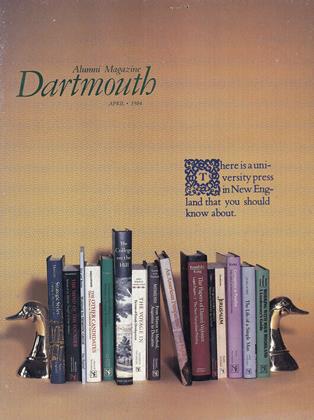The Hanover Plain must have been a hotbed of creative activity three-quarters of a century ago, for the past year has seen several notable campus institutions celebrating 75th anniversaries. Joining the Outing Club and the ALUMNI MAGAZINE in marking that milestone this year is the Jack-o-Lantein billed as the "Dartmouth Comic Monthly" in its early years.
The first issue, dated March 1909, is modestly decribed by its editors as "the first periodical of its kind, we believe, that has ever been offered to the College." Readers were apprised that "the cover design will be changed every issue"; that "the whole magazine will be bountifully illustrated"; and that submissions of "brief poems and short humorous stories will be in order." High hopes were expressed for the new publication: "Our literary organs have, of late, improved greatly; it's up to you to... help Jack-o-Lantern to take its place among no, at the head of all college magazines of its type."
Those first editions were 24-page compendiums of one-liners, cartoons, doggerel verse, and satirical sketches that are as amusing today for their dated tone as for their intrinsic humor. Fifteen years later, the Jack-o had grown to 48 pages and featured color on its covers and a later-to-be-famous name on its masthead. Theodor Geisel '23— known to most as Dr. Seuss —is one of many young Dartmouth writers and artists who got a start on the Jack-o and went on to notable careers in the field.
In its first several decades, the Jack-o was nimble at attracting advertising as well as editorial talent. Nearly half its pages proclaimed the virtues of national products such as Hammond Type- writers ("this instrument has all of those neat devices which you wish your machine had") and local emporiums such as the Dartmouth Pharmacy ("people of taste drink our soda because of its unexcelled flavor and quality").
It might be said that all advertising and no humor would make Jack-o a dull boy but all humor and no advertising has brought the house that Jack-o built on hard times in recent years. A decline in advertising revenues (due to the increased number of student publications competing for the same few advertisers), combined with the inability of the College's limited subsidy to cover rising printing costs, reduced the Jack-o's frequency to one or two issues a year in the past decade; the last issue was put out in the spring of 1982.
Most editions of recent years have been parodies of the ALUMNI MAGAZINE, the Review, the Green Key calendar or theme issues. But now, to celebrate the 75th, a newly active group is planning to publish a 40 to 50 page edition half a selection of some of the best material from past issues and half new material. Robert Levine '86 said that about a dozen students are involved in the revival effort trying to do fund-raising, recruiting new members, soliciting pieces from Jacko alumni. They're all pitching into the effort "there's very little defined in terms of positions," Levine noted, as a contrast to the days when the masthead featured dozens of names in clearlydelineated departments. Perhaps that makes Levine (as well as his cohorts) a Jacko-all-trades or at least of the venerable calling of publishing college humor magazines.
 View Full Issue
View Full Issue
More From This Issue
-
 Cover Story
Cover StoryConsortium
April 1984 By Shelby Grantham -
 Feature
FeatureHanover Sabbatical
April 1984 By Robert Conn '61 -
 Feature
FeatureCenters of Excellence and the Survival of Creativity
April 1984 By O. Ross Mclntyre '53 -
 Feature
FeatureRobert Frost Keeps Me Company Often Uninvited
April 1984 By Kenneth Andler '26 -
 Article
ArticleIt's Just Like Talking to People
April 1984 By Debbie Schupack '84 -
 Class Notes
Class Notes1959
April 1984 By William G. Long
Article
-
 Article
ArticleIs It Worth The Cost?
AUGUST, 1927 -
 Article
ArticleContributions by Classes in the 1945 Alumni Fund Campaign
January 1946 -
 Article
ArticleAn American in Tokyo
DECEMBER 1984 -
 Article
ArticleHollywood at Work
November 1938 By BENFIELD PRESSEY -
 Article
ArticlePreservation of Democracy
January 1941 By CLYDE C. HALL '26 -
 Article
ArticleThayer School
FEBRUARY 1965 By RUSS STEARNS '38


